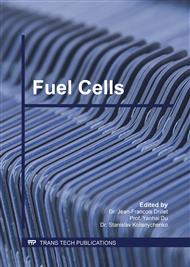p.59
p.64
p.69
p.74
p.78
p.83
p.88
p.93
p.101
Preparation of Nano-Structured Cathode for Proton-Conducting Fuel Cell by Dispersing Agent-Assisted Sol-Gel Method
Abstract:
The development of high-performance cathodes is essential towards the operation of proton-conducting fuel cells (PCFCs) at intermediate temperatures. To that end, the performance of La0.6Sr0.4Co0.2Fe0.8O3-δ (LSCF) cathodes is very attractive. In the present works, LSCF cathode powders were synthesized by a sol-gel method with the aid of ethylene glycol which served as the dispersing agent. The pristine and modified samples were each denoted as LSCF64 and LSCF-EG5. The phase formation and morphology of the cathode powders were examined by X-Ray diffractometer (XRD) and field emission scanning electron microscopy (FESEM), respectively. In order to evaluate the cathode performance, a symmetrical cell of electrolyte supported PCFCs were examined using an electrochemical impedance spectroscopy (EIS) at a 700 oC in atmosphere containing humidified air. The formation of LSCF single phase was attained at 700 °C for both prepared samples. The FESEM images confirms an improvement in the microstructure of the modified cathode. The impedance spectra obtained from the electrochemical impedance measurement were resolved by a fitting procedure using an equivalent circuit that consists of a combination of two parallel pairs of resistor-constant phase element (R-Q) in series. The area specific resistance (ASR) determined for LSCF64 and LSCF-EG5 is 1.55 and 0.23 Ωcm2 , respectively. The better performance exhibited by LSCF-EG5 is attributed to its higher cathode reaction site due the improved microstucture. This study reveals that the application of ethylene glycol as dispersing agent is effective in producing a high quality cathode material for better PCFCs performance.
Info:
Periodical:
Pages:
78-82
Citation:
Online since:
March 2018
Authors:
Price:
Сopyright:
© 2018 Trans Tech Publications Ltd. All Rights Reserved
Share:
Citation:



